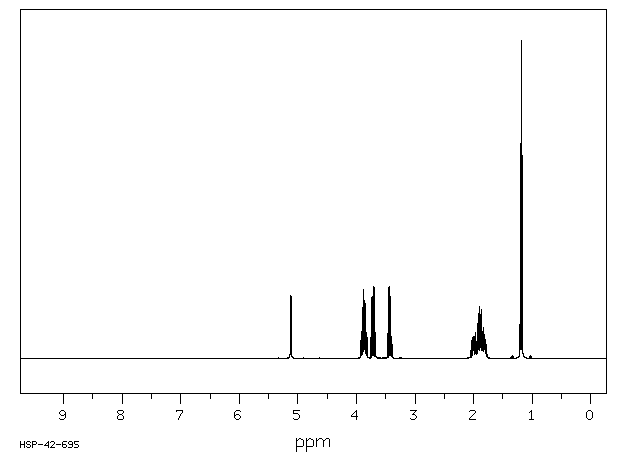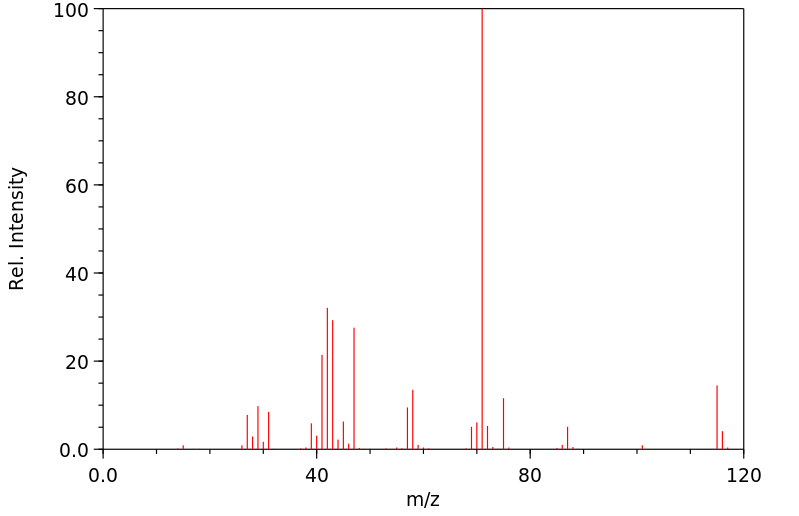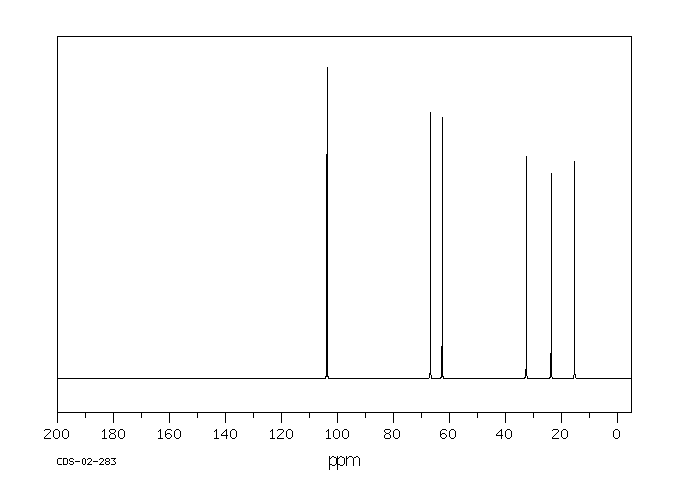2-乙氧基四氢呋喃 | 13436-46-9
中文名称
2-乙氧基四氢呋喃
中文别名
——
英文名称
2-ethoxytetrahydrofuran
英文别名
2-ethoxyoxolane
CAS
13436-46-9
化学式
C6H12O2
mdl
MFCD00005360
分子量
116.16
InChiKey
JQYYUWHWGCJWTN-UHFFFAOYSA-N
BEILSTEIN
——
EINECS
——
-
物化性质
-
计算性质
-
ADMET
-
安全信息
-
SDS
-
制备方法与用途
-
上下游信息
-
文献信息
-
表征谱图
-
同类化合物
-
相关功能分类
-
相关结构分类
物化性质
-
沸点:170-172 °C (lit.)
-
密度:0.908 g/mL at 25 °C (lit.)
-
闪点:61 °F
-
LogP:0.130 (est)
-
保留指数:790;790;816;823
计算性质
-
辛醇/水分配系数(LogP):0.9
-
重原子数:8
-
可旋转键数:2
-
环数:1.0
-
sp3杂化的碳原子比例:1.0
-
拓扑面积:18.5
-
氢给体数:0
-
氢受体数:2
安全信息
-
危险等级:3.1
-
危险品标志:F
-
安全说明:S16,S29,S33
-
危险类别码:R11
-
海关编码:2932190090
-
包装等级:II
-
危险类别:3.1
-
危险标志:GHS02
-
危险品运输编号:UN 1993 3/PG 2
-
危险性描述:H225
-
危险性防范说明:P210
SDS
SECTION 1: Identification of the substance/mixture and of the company/undertaking
Product identifiers
Product name : 2-Ethoxytetrahydrofuran
REACH No. : A registration number is not available for this substance as the substance
or its uses are exempted from registration, the annual tonnage does not
require a registration or the registration is envisaged for a later
registration deadline.
CAS-No. : 13436-46-9
SECTION 2: Hazards identification
Classification of the substance or mixture
Classification according to Regulation (EC) No 1272/2008
Flammable liquids (Category 2), H225
For the full text of the H-Statements mentioned in this Section, see Section 16.
Classification according to EU Directives 67/548/EEC or 1999/45/EC
F Highly flammable R11
For the full text of the R-phrases mentioned in this Section, see Section 16.
Label elements
Labelling according Regulation (EC) No 1272/2008
Pictogram
Signal word Danger
Hazard statement(s)
Highly flammable liquid and vapour.
Precautionary statement(s)
Keep away from heat/sparks/open flames/hot surfaces. - No smoking.
Supplemental Hazard none
Statements
Other hazards - none
SECTION 3: Composition/information on ingredients
Substances
Formula : C6H12O2
Molecular Weight : 116,16 g/mol
CAS-No. : 13436-46-9
EC-No. : 236-569-9
Hazardous ingredients according to Regulation (EC) No 1272/2008
Component Classification Concentration
2-Hydroxytetrahydrofuran
CAS-No. 13436-46-9 Flam. Liq. 2; H225 <= 100 %
EC-No. 236-569-9
For the full text of the H-Statements and R-Phrases mentioned in this Section, see Section 16
SECTION 4: First aid measures
Description of first aid measures
General advice
Consult a physician. Show this safety data sheet to the doctor in attendance.
If inhaled
If breathed in, move person into fresh air. If not breathing, give artificial respiration. Consult a physician.
In case of skin contact
Wash off with soap and plenty of water. Consult a physician.
In case of eye contact
Flush eyes with water as a precaution.
If swallowed
Do NOT induce vomiting. Never give anything by mouth to an unconscious person. Rinse mouth with
water. Consult a physician.
Most important symptoms and effects, both acute and delayed
The most important known symptoms and effects are described in the labelling (see section 2.2) and/or in
section 11
Indication of any immediate medical attention and special treatment needed
no data available
SECTION 5: Firefighting measures
Extinguishing media
Suitable extinguishing media
For small (incipient) fires, use media such as "alcohol" foam, dry chemical, or carbon dioxide. For large
fires, apply water from as far as possible. Use very large quantities (flooding) of water applied as a mist or
spray; solid streams of water may be ineffective. Cool all affected containers with flooding quantities of
water.
Special hazards arising from the substance or mixture
Carbon oxides
Advice for firefighters
Wear self contained breathing apparatus for fire fighting if necessary.
Further information
Use water spray to cool unopened containers.
SECTION 6: Accidental release measures
Personal precautions, protective equipment and emergency procedures
Avoid breathing vapours, mist or gas. Ensure adequate ventilation. Remove all sources of ignition.
Evacuate personnel to safe areas. Beware of vapours accumulating to form explosive concentrations.
Vapours can accumulate in low areas.
For personal protection see section 8.
Environmental precautions
Prevent further leakage or spillage if safe to do so. Do not let product enter drains.
Methods and materials for containment and cleaning up
Contain spillage, and then collect with an electrically protected vacuum cleaner or by wet-brushing and
place in container for disposal according to local regulations (see section 13).
Reference to other sections
For disposal see section 13.
SECTION 7: Handling and storage
Precautions for safe handling
Avoid inhalation of vapour or mist.
Keep away from sources of ignition - No smoking.Take measures to prevent the build up of electrostatic
charge.
For precautions see section 2.2.
Conditions for safe storage, including any incompatibilities
Store in cool place. Keep container tightly closed in a dry and well-ventilated place. Containers which are
opened must be carefully resealed and kept upright to prevent leakage.
Specific end use(s)
A part from the uses mentioned in section 1.2 no other specific uses are stipulated
SECTION 8: Exposure controls/personal protection
Control parameters
Components with workplace control parameters
Exposure controls
Appropriate engineering controls
Handle in accordance with good industrial hygiene and safety practice. Wash hands before breaks and
at the end of workday.
Personal protective equipment
Eye/face protection
Face shield and safety glasses Use equipment for eye protection tested and approved under
appropriate government standards such as NIOSH (US) or EN 166(EU).
Skin protection
Handle with gloves. Gloves must be inspected prior to use. Use proper glove removal technique
(without touching glove's outer surface) to avoid skin contact with this product. Dispose of
contaminated gloves after use in accordance with applicable laws and good laboratory practices.
Wash and dry hands.
The selected protective gloves have to satisfy the specifications of EU Directive 89/686/EEC and
the standard EN 374 derived from it.
Body Protection
impervious clothing, Flame retardant antistatic protective clothing, The type of protective
equipment must be selected according to the concentration and amount of the dangerous
substance at the specific workplace.
Respiratory protection
Where risk assessment shows air-purifying respirators are appropriate use a full-face respirator
with multi-purpose combination (US) or type ABEK (EN 14387) respirator cartridges as a backup
to engineering controls. If the respirator is the sole means of protection, use a full-face supplied air
respirator. Use respirators and components tested and approved under appropriate government
standards such as NIOSH (US) or CEN (EU).
Control of environmental exposure
Prevent further leakage or spillage if safe to do so. Do not let product enter drains.
SECTION 9: Physical and chemical properties
Information on basic physical and chemical properties
a) Appearance Form: liquid
b) Odour no data available
c) Odour Threshold no data available
d) pH no data available
e) Melting point/freezing no data available
point
f) Initial boiling point and 170 - 172 °C - lit.
boiling range
g) Flash point 16 °C - closed cup
h) Evapouration rate no data available
i) Flammability (solid, gas) no data available
j) Upper/lower no data available
flammability or
explosive limits
k) Vapour pressure no data available
l) Vapour density no data available
m) Relative density 0,908 g/cm3 at 25 °C
n) Water solubility no data available
o) Partition coefficient: n- no data available
octanol/water
p) Auto-ignition no data available
temperature
q) Decomposition no data available
temperature
r) Viscosity no data available
s) Explosive properties no data available
t) Oxidizing properties no data available
Other safety information
no data available
SECTION 10: Stability and reactivity
Reactivity
no data available
Chemical stability
Stable under recommended storage conditions.
Possibility of hazardous reactions
no data available
Conditions to avoid
Heat, flames and sparks. Extremes of temperature and direct sunlight.
Incompatible materials
Oxidizing agents, Strong acids
Hazardous decomposition products
Other decomposition products - no data available
In the event of fire: see section 5
SECTION 11: Toxicological information
Information on toxicological effects
Acute toxicity
no data available
Skin corrosion/irritation
no data available
Serious eye damage/eye irritation
no data available
Respiratory or skin sensitisation
no data available
Germ cell mutagenicity
no data available
Carcinogenicity
IARC: No component of this product present at levels greater than or equal to 0.1% is identified as
probable, possible or confirmed human carcinogen by IARC.
Reproductive toxicity
no data available
Specific target organ toxicity - single exposure
no data available
Specific target organ toxicity - repeated exposure
no data available
Aspiration hazard
no data available
Additional Information
RTECS: Not available
To the best of our knowledge, the chemical, physical, and toxicological properties have not been
thoroughly investigated.
SECTION 12: Ecological information
Toxicity
no data available
Persistence and degradability
no data available
Bioaccumulative potential
no data available
Mobility in soil
no data available
Results of PBT and vPvB assessment
PBT/vPvB assessment not available as chemical safety assessment not required/not conducted
Other adverse effects
no data available
SECTION 13: Disposal considerations
Waste treatment methods
Product
Burn in a chemical incinerator equipped with an afterburner and scrubber but exert extra care in igniting
as this material is highly flammable. Offer surplus and non-recyclable solutions to a licensed disposal
company. Contact a licensed professional waste disposal service to dispose of this material.
Contaminated packaging
Dispose of as unused product.
SECTION 14: Transport information
UN number
ADR/RID: 1993 IMDG: 1993 IATA: 1993
UN proper shipping name
ADR/RID: FLAMMABLE LIQUID, N.O.S. (2-Hydroxytetrahydrofuran)
IMDG: FLAMMABLE LIQUID, N.O.S. (2-Hydroxytetrahydrofuran)
IATA: Flammable liquid, n.o.s. (2-Hydroxytetrahydrofuran)
Transport hazard class(es)
ADR/RID: 3 IMDG: 3 IATA: 3
Packaging group
ADR/RID: II IMDG: II IATA: II
Environmental hazards
ADR/RID: no IMDG Marine pollutant: no IATA: no
Special precautions for user
no data available
SECTION 15: Regulatory information
This safety datasheet complies with the requirements of Regulation (EC) No. 1907/2006.
Safety, health and environmental regulations/legislation specific for the substance or mixture
no data available
Chemical Safety Assessment
SECTION 16 - ADDITIONAL INFORMATION
N/A
上下游信息
-
上游原料
中文名称 英文名称 CAS号 化学式 分子量 2-甲氧基四氢呋喃 2-methoxytetrahydrofuran 13436-45-8 C5H10O2 102.133
反应信息
-
作为反应物:参考文献:名称:Oxidation of cyclic acetals by ozone in ionic liquid media摘要:将臭氧稳定的吡咯烷鎓基离子液体作为安全反应介质的应用,在环状缩醛的臭氧化反应中,无需使用低温或乙酰化试剂即可实现高选择性的羟基酯形成。DOI:10.1039/b913431j
-
作为产物:参考文献:名称:Synthesis and properties of furan derivatives 2. Role of the halogen in RMgX in reactions with alkoxytetrahydrofurans摘要:DOI:10.1007/bf00475242
-
作为试剂:参考文献:名称:双 Prins 环化能够快速获得 α,ω-羟基四氢吡喃摘要:螺缩酮部分是许多天然产物的重要子结构,通常通过将羟基侧基氧化环化到预先形成的吡喃上来制备。然而,迄今为止,获得此类前体一直具有挑战性。报道了一种制备羟基二和羟基四氢吡喃的新方法,该方法使用一种新的双 Prins 环化方法。DOI:10.1002/ejoc.202200810
文献信息
-
Bi(III) halides as efficient catalysts for the O-acylative cleavage of tetrahydrofurans: an expeditious entry to tetralins作者:Simon J. Coles、James F. Costello、William N. Draffin、Michael B. Hursthouse、Simon P. PaverDOI:10.1016/j.tet.2005.02.080日期:2005.5O-acylative cleavage of tetrahydrofurans using organic acid halides with catalytic Bi(III) halides is reported. X-ray crystallography is used to rationalise the failure of the reaction in the case of certain crowded acid chlorides, and a useful aspect of chemoselectivity is revealed. The synthetic potential of this reaction is illustrated with a highly efficient O-acylative cleavage/intramolecular
-
Antagonists of gonadotropin releasing hormone申请人:Merck & Co., Inc.公开号:US05756507A1公开(公告)日:1998-05-26There are disclosed compounds of formula (I) ##STR1## and pharmaceutically acceptable salts thereof which are useful as antagonists of GnRH and as such may be useful for the treatment of a variety of sex-hormone related and other conditions in both men and women.公式(I)的化合物及其药学上可接受的盐已被披露,它们可作为GnRH拮抗剂,并因此可能对男性和女性的各种性激素相关和其他疾病的治疗有用。
-
Aminosilyl-Substituted Diarylethene Compounds for Anionic Polymerisation申请人:Trinseo Europe GmbH公开号:US20170204119A1公开(公告)日:2017-07-20The invention related to novel compounds useful as modifying monomers and precursors for polymerization initiators. The invention further relates to a method of making the polymerization initiators and resulting polymers. The invention also relates to polymer compositions comprising the polymer of the invention and further components such as extender oils, fillers, vulcanizing agents etc., and to corresponding vulcanized polymer compositions and articles comprising vulcanized parts made from the vulcanized polymer composition.
-
PPAR active compounds申请人:Lin Jack公开号:US20080249137A1公开(公告)日:2008-10-09Compounds are described that are active on at least one of PPARα, PPARδ, and PPARγ, which are useful for therapeutic and/or prophylactic methods involving modulation of at least one of PPARα, PPARδ, and PPARγ.
-
[EN] SUBSTITUTED NITROGEN CONTAINING COMPOUNDS<br/>[FR] COMPOSÉS CONTENANT DE L'AZOTE SUBSTITUÉ申请人:BRISTOL MYERS SQUIBB CO公开号:WO2018222795A1公开(公告)日:2018-12-06Disclosed are compounds of Formula (I): or a salt thereof, Formula (II) wherein R1 is: or; each W is independently NR1b or O; Z is a bond or CHR1d; and R1, R2, Rd, R3a, R3b, L1, B, V, Y, and n are defined herein. Also disclosed are methods of using such compounds as inhibitors of ROMK, and pharmaceutical compositions comprising such compounds. These compounds are useful in treating cardiovascular diseases.揭示了以下式(I)的化合物或其盐,式(II)其中R1是:或;每个W独立地是NR1b或O;Z是键或CHR1d;以及R1、R2、Rd、R3a、R3b、L1、B、V、Y和n在此处被定义。还揭示了将这些化合物用作ROMK抑制剂的方法,以及包含这些化合物的药物组合物。这些化合物在治疗心血管疾病方面是有用的。
表征谱图
-
氢谱1HNMR
-
质谱MS
-
碳谱13CNMR
-
红外IR
-
拉曼Raman
-
峰位数据
-
峰位匹配
-
表征信息
同类化合物
顺式-环氧丙烷-3,4-二胺二盐酸盐
顺式-2-(碘甲基)-3-羟基四氢呋喃
顺式-2-(碘甲基)-3-羟基四氢呋喃
青榄呋喃
茶香螺烷
苯胺,4-(2-哌嗪基)-
碳氯灵
硼烷四氢呋喃络合物
硫丹乙酯
甲基甲丙烯酰酸酯-叔丁基甲丙烯酰酸酯-月桂基甲丙烯酰酸酯共聚物
甲基丙烯酸四氢糠基酯
甲基[(噁戊环-2-基)甲基]胺盐酸
甲基2,5-脱水-3-脱氧戊酮酸酯
甲基(四氢呋喃-2-基甲基)砜
牛蝇畏
溴化锰(II)双(四氢呋喃)
溴化亚铁(II),双(四氢呋喃)
氧化芳樟醇
氘代四氢呋喃
异硫氰酸氢糠酯
异丙基-(四氢-呋喃-2-甲基)-胺
失水山梨醇
四氯双(四氢呋喃)合铌(IV)
四氢糠醇乙酸酯
四氢糠醇丙酸酯
四氢糠醇
四氢糠基硫醇
四氢呋喃氯化钛
四氢呋喃-D4
四氢呋喃-3-甲醛
四氢呋喃-2-甲醛
四氢呋喃-2-甲酰肼盐酸盐
四氢呋喃-2-乙酸
四氢呋喃
四氢-alpha-戊基-2-呋喃乙醇乙酸酯
四氢-alpha-[2-(四氢呋喃-2-基)乙基]-2-呋喃-1-丙醇
四氢-alpha,alpha,5-三甲基-5-乙烯基糠基乙酸酯
四氢-alpha,alpha,5-三甲基-5-(4-甲基-3-环己烯-1-基)呋喃-2-甲醇
四氢-N-[(四氢-2-呋喃基)甲基]-2-呋喃甲胺
四氢-N,2-二甲基-2-糠基胺
四氢-Alpha-戊基-2-呋喃甲醇乙酸酯
四氢-5-羟基呋喃-2-甲醇
四氢-5-甲基呋喃-2-甲醇
四氢-2-辛基呋喃
四氢-2-甲基-2-呋喃醇
四氢-2-呋喃基甲基3-氯丙酸酯
四氢-2-呋喃基氯乙酸甲酯
四氢-2-呋喃丙醇
四氢-2-呋喃-1-丙醇丙酸酯
呋喃,2-(二氯甲基)四氢-










